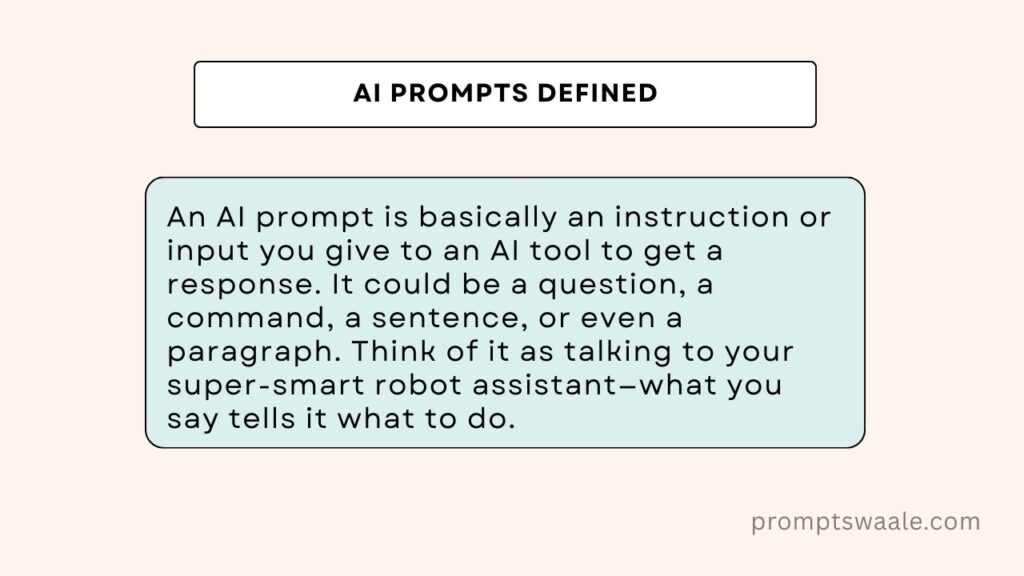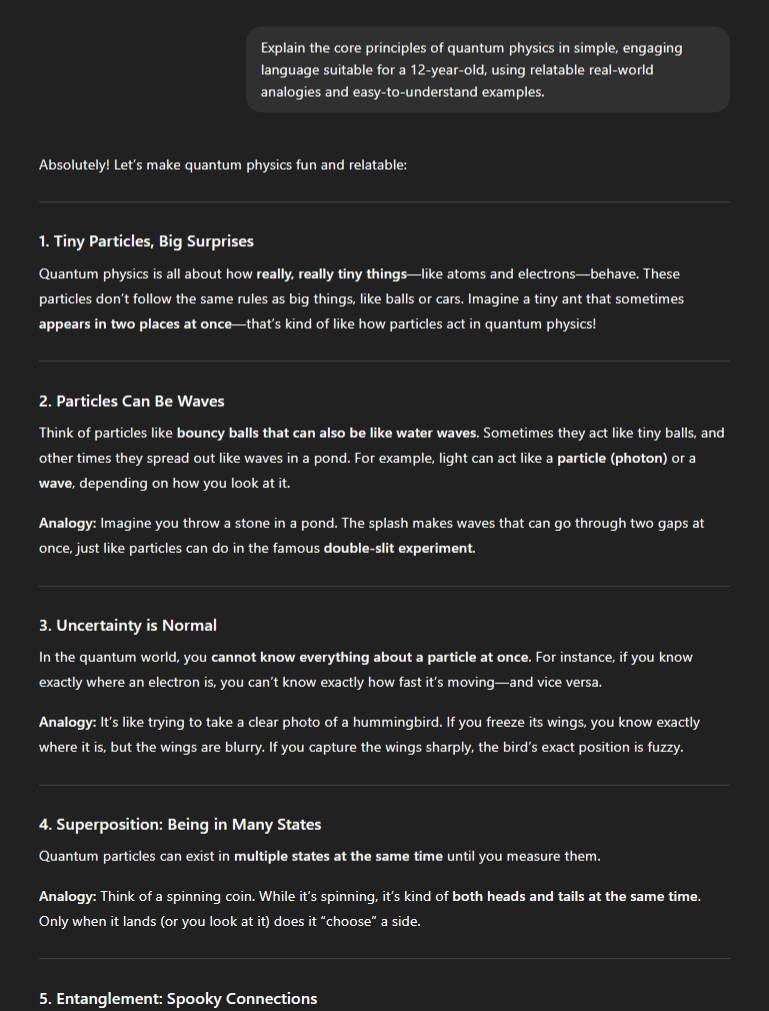
Introduction
Have you asked ChatGPT or requested MidJourney to create an image for you? Well, if yes, you have already used an AI prompt without even realizing it! But what is an AI prompt, and why is everyone talking about it? If you’re wondering, confused or completely new to the world of artificial intelligence, this beginner-friendly guide will give you all the answers you need.
Let’s break it down in plain English-no tech jargon, no fluff.
Understanding the Basics
AI Prompts Defined
An AI prompt is basically an instruction or input you give to an AI tool to get a response. It could be a question, a command, a sentence, or even a paragraph. Think of it as talking to your super-smart robot assistant, what you say tells it what to do.

Role of AI Prompts in Generative AI
In apps like ChatGPT, Jasper, MidJourney, and DALL·E, prompts are where it begins. The AI, using your prompt, “understands” what you want, and then generates text, images, code or audio based on that.
Also Read: 15 Best ChatGPT Prompts to Learn New Skills
Real-Life Analogy to Understand AI Prompts
Imagine AI as a magic genie. But instead of saying “I wish…”, you type out a clear instruction. The better your wish (prompt), the better the genie performs.
Types of AI Prompts
1. Text Prompts
These are the most common. You type in something like:
“Write a self-help speech in the Tony Robbins mode.”
And boom-the AI delivers.
2. Image Prompts
These are descriptions used in image generators such as MidJourney and DALL·E:
“A nighttime cyberpunk city with neon lights and flying cars.”
The AI then reproduces an image from that.
3. Code Prompts
Developers can hot-press code using prompts:
“Create a program that will send an email using Python.”
In just a few seconds, AI spits out working code.
4. Voice Prompts
Think of Alexa or Siri. When you say:
“What’s the weather like today?”
That’s a voice prompt. AI translates it into action.
How AI Understands Prompts
AI understands prompts through a process called natural language processing (NLP). When you type a prompt, the AI breaks it down into tokens (small pieces of text), analyzes their meaning, and interprets the intent behind your words. It uses patterns learned from vast amounts of training data to predict the most relevant and coherent response. Context plays a crucial role, AI considers not just the words you use, but also the tone, specificity, and any prior conversation. Well-structured, clear prompts help the AI generate more accurate, useful outputs.
In essence, the AI doesn’t “think” like humans; it predicts what should come next based on probabilities, ensuring the response aligns as closely as possible with your request.
Also Read: Prompt Engineering 101: How to Write Better AI Prompts
Why AI Prompts Matter
Better Prompts = Better Outputs
Ever heard the phrase, “garbage in, garbage out”? Same goes for AI. Your human-written prompt will have a direct impact on the quality of the result.
Use Cases of AI Prompts in Daily Life
- Writing emails or blogs
- Creating social media content
- Getting quick summaries
- Brainstorming ideas
- Automating repetitive tasks
You don’t have to be a techie. Just know how to ask properly.
Examples of AI Prompts
1. Prompts for Writing
“Write a well-structured, 1,000-word blog post discussing the physical and mental health benefits of daily meditation for busy professionals, including practical tips for integrating it into a tight schedule.”
2. Prompts for Learning and Tutoring
“Explain the core principles of quantum physics in simple, engaging language suitable for a 12-year-old, using relatable real-world analogies and easy-to-understand examples.”

3. Prompts for Business and Productivity
“Create a compelling investor pitch for a startup offering an innovative vegan protein snack, highlighting its unique selling points, target market, sustainability benefits, and potential for growth.”
4. Prompts for Fun and Entertainment
“Write a whimsical bedtime story about a curious time-traveling cat who visits different eras in history, helping characters solve problems along the way, with a heartwarming ending.”

There’s a prompt for literally everything!
Also Read: 10 Best ChatGPT Alternatives for Researchers in 2025
How to Write Effective AI Prompts
Keep It Clear and Concise
Avoid rambling. AI prefers short and clear commands.
Bad: “Can you maybe help me write something about marketing strategies or whatever works best?”
Good: “Write 5 modern marketing strategies for small businesses.”
Be Specific, Not Vague
Instead of saying “write a paragraph,” say “write a motivational paragraph using the quote ‘Never give up.’”
Use Step-by-Step Instructions
Break your task into parts. AI works better with structure:
“Step 1: Create a catchy headline.
Step 2: Write a short intro.
Step 3: Add 3 bullet points.”
Common Mistakes with AI Prompts
One of the most common mistakes when using AI is being too general. A prompt like “write something about dogs” is vague and leaves the AI guessing what you really want. Are you looking for a funny story, a factual article, or a poem? The more specific your prompt, the better the AI can deliver content that matches your expectations.
Another frequent error is forgetting context. AI doesn’t automatically know your intentions or audience. If you want a casual blog post for teenagers, a formal report for professionals, or a persuasive social media caption, you need to mention it. Without context, the AI might produce content that doesn’t fit your needs.
Lastly, many people expect magic without details. AI is incredibly powerful, but it isn’t a mind reader. Providing clear instructions, examples, or constraints improves results significantly. For instance, instead of asking, “write about marketing,” you could say, “write a 200-word social media post explaining Instagram marketing tips for small businesses in a friendly tone.” This way, the AI understands what you want, who it’s for, and how it should sound.
Avoiding these mistakes ensures your prompts are effective, saving time and producing high-quality AI-generated content.
The Future of AI Prompts
1. Prompt Marketplaces
Yes, people are selling prompts now! Websites like PromptBase allow you to buy and sell high-quality prompts for different AI tools.
2. AI Prompt Engineers: A New Career Path
Believe it or not, there are companies that are hiring “prompt engineers” who specialize in writing instructions for AI. It’s a legit job now!
Conclusion
So, what is an AI prompt? Put simply, it’s how you (a human) talk to AI in order to get things done – whether that be writing a poem, generating some code, creating a logo, solving a business problem, etc. It’s the magic key to unlock AI’s full potential. The better you get at prompting, the more powerful your AI experience becomes.
Just remember: you don’t need to be a genius, just learn how to ask smartly.
FAQs
- What is the purpose of an AI prompt?
To guide AI tools in generating specific outputs like text, images, or code based on user instructions. - Can anyone write AI prompts?
Absolutely! If you can type a question, you can write a prompt. No technical skills needed. - Are AI prompts different for each AI model?
Yes. ChatGPT, MidJourney, and other tools may respond differently depending on how they’re trained and what type of prompts they accept. - How do I start creating my own prompts?
Just start experimenting! Begin with simple instructions and refine based on the results you get. - Is prompt engineering hard to learn?
Not at all. It’s more about practice and creativity than technical knowledge. The more you play with prompts, the better you get.
